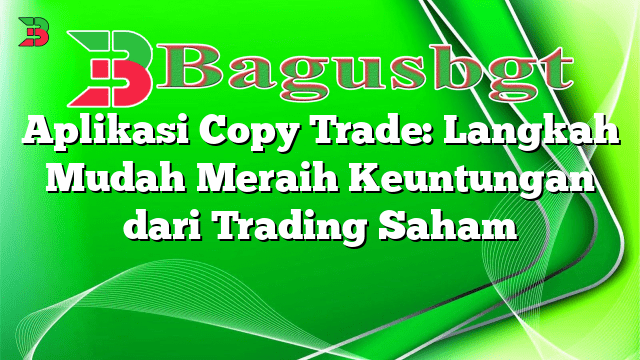Hello readers, welcome to our comprehensive guide on the best trading platforms for forex. In this article, we will explore the top platforms available in the market, their features, advantages, disadvantages, and alternative options. Whether you are a beginner or an experienced trader, choosing the right trading platform is crucial for your success in the forex market. So, let’s dive in and find the perfect platform for your forex trading needs.
1. MetaTrader 4 (MT4)
MetaTrader 4, developed by MetaQuotes Software, is one of the most popular trading platforms in the forex industry. It offers a wide range of features, including advanced charting tools, customizable indicators, automated trading options, and a user-friendly interface. The platform also provides access to a large community of traders and expert advisors. However, MT4 has some limitations, such as outdated technology and a lack of integration with other markets.
2. MetaTrader 5 (MT5)
MetaTrader 5 is the successor to MT4 and offers enhanced features and capabilities. It provides traders with advanced charting tools, a wide range of technical indicators, and the ability to trade various asset classes, including forex, stocks, and commodities. MT5 also allows for algorithmic trading and supports multiple order types. However, the learning curve for MT5 can be steeper compared to MT4, and not all brokers offer this platform.
3. cTrader
cTrader is a popular trading platform known for its advanced trading capabilities and intuitive user interface. It offers features such as level II pricing, depth of market, and fast order execution. cTrader also provides a range of charting tools, advanced order types, and a customizable layout. However, it may not be as widely supported by brokers as the MetaTrader platforms.
4. NinjaTrader
NinjaTrader is a powerful trading platform that caters to advanced traders. It offers a wide range of features, including advanced charting, backtesting capabilities, and an extensive library of trading indicators. NinjaTrader also supports automated trading and provides access to various markets, including forex, stocks, and futures. However, the platform has a steep learning curve and may not be suitable for beginners.
5. TradingView
TradingView is a popular web-based platform that provides traders with real-time market data, advanced charting tools, and social networking capabilities. It offers a wide range of technical analysis indicators and drawing tools, making it ideal for traders who rely heavily on technical analysis. However, TradingView is primarily a charting platform and may lack some of the advanced trading features offered by other platforms.
6. eToro
eToro is a social trading platform that allows users to copy the trades of successful traders. It offers a user-friendly interface, a wide range of trading instruments, and social networking features. eToro also provides a unique feature called “CopyTrading,” which allows users to automatically replicate the trades of top-performing traders. However, eToro’s fees can be higher compared to other platforms, and it may not be suitable for advanced traders looking for advanced technical analysis tools.
7. Interactive Brokers
Interactive Brokers is a well-known brokerage firm that offers a comprehensive trading platform for forex and other asset classes. It provides access to a wide range of markets, advanced order types, and powerful trading tools. Interactive Brokers also offers competitive pricing and a variety of account types to suit different trading needs. However, the platform can be overwhelming for beginners, and the minimum deposit requirement is relatively high.
8. Saxo Bank
Saxo Bank is a reputable online broker that offers a powerful trading platform known as SaxoTraderGO. It provides access to a wide range of markets, advanced charting tools, and comprehensive trading features. SaxoTraderGO also offers a user-friendly interface and a mobile app for trading on the go. However, Saxo Bank’s fees can be higher compared to other brokers, and the platform may not be suitable for beginners.
9. Plus500
Plus500 is a popular trading platform known for its simplicity and ease of use. It offers a user-friendly interface, a wide range of trading instruments, and competitive pricing. Plus500 also provides a free demo account for beginners to practice their trading skills. However, the platform may lack some advanced features and customization options compared to other platforms.
10. Alternative Options
Aside from the mentioned platforms, there are other alternative options available in the market. Some of these include TradeStation, XTB, OANDA, and IG. Each platform has its own set of features, advantages, and disadvantages, so it’s important to research and compare them to find the best fit for your trading needs.
Comparison Table
Platform |
Features |
Advantages |
Disadvantages |
|---|---|---|---|
MetaTrader 4 (MT4) |
Advanced charting, automated trading, large community |
User-friendly interface, customizable indicators |
Outdated technology, lack of integration |
MetaTrader 5 (MT5) |
Advanced charting, multiple asset classes |
Algorithmic trading, various order types |
Steep learning curve, limited broker support |
cTrader |
Level II pricing, fast order execution |
Advanced trading capabilities, intuitive interface |
Limited broker support |
NinjaTrader |
Advanced charting, backtesting capabilities |
Extensive library of trading indicators |
Steep learning curve, not suitable for beginners |
TradingView |
Real-time market data, social networking |
Wide range of technical analysis tools |
Lacks advanced trading features |
eToro |
Social trading, user-friendly interface |
Wide range of trading instruments |
Higher fees, limited technical analysis tools |
Interactive Brokers |
Access to various markets, advanced order types |
Competitive pricing, different account types |
Overwhelming for beginners, high minimum deposit |
Saxo Bank |
Advanced charting, comprehensive trading features |
User-friendly interface, mobile app |
Higher fees, not suitable for beginners |
Plus500 |
User-friendly interface, wide range of instruments |
Competitive pricing, free demo account |
Lacks advanced features, limited customization |
Conclusion
In conclusion, choosing the best trading platform for forex requires careful consideration of your trading goals, experience level, and preferred features. The platforms mentioned in this article are some of the top options available, each with its own strengths and weaknesses. It’s important to thoroughly research and compare these platforms to find the one that best suits your needs. Remember to consider factors such as user-friendliness, advanced trading features, available markets, and fees. Happy trading!
Frequently Asked Questions (FAQ)
Q: Can I use multiple trading platforms?
A: Yes, you can use multiple trading platforms simultaneously. Many traders use different platforms for different purposes, such as charting, executing trades, and accessing specific markets.
Q: Are these platforms available on mobile devices?
A: Yes, most trading platforms offer mobile apps for both iOS and Android devices, allowing you to trade on the go.
Q: Do I need to pay for these trading platforms?
A: It depends. Some platforms offer free access to their basic features, while others may require a subscription fee or charge for advanced features and data.
Q: Can I try these platforms before committing to them?
A: Yes, many platforms offer free demo accounts that allow you to test their features and functionalities without risking real money.
Q: Can I trade forex without using a trading platform?
A: Technically, it is possible to trade forex without using a trading platform, but it would be highly impractical. Trading platforms provide essential tools and features that make the trading process more efficient and convenient.
 Bagus Banget Kumpulan Informasi terbaru dari berbagai sumber yang terpercaya
Bagus Banget Kumpulan Informasi terbaru dari berbagai sumber yang terpercaya




